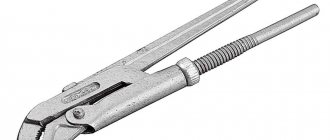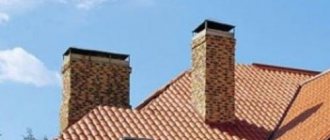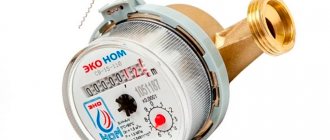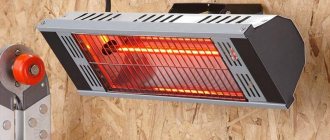The lack of a centralized sewer line in villages with country houses and almost always in summer cottages forces owners to independently solve the problem of fecal waste disposal. The only way out of this situation is an autonomous sewage system in the country, which has various options.
In order to optimally choose a dacha sewer system, it is necessary to take into account the time intervals and seasonality of the owners being in the house, their financial security, and the distance of the site from populated areas. Basically, based on these factors, the necessary structural device, layout and type of sewage system are selected.
Rice. 1 Scheme of a domestic sewerage system with a septic tank and a filtration field
Checklist for beginners
It is impossible to decide on the type of waste disposal device until you describe in detail the conditions of its operation that exist on the site. A member of our portal with the nickname sonder RZN has compiled a checklist for those who are choosing and considering a sewerage scheme in a private house. It doesn’t matter whether you do it yourself or with the help of specialists: these questions still need to be answered.
- Determine the type of soil on the site. This can be done at home - just roll the soil into a sausage.
Geolog197FORUMHOUSE Member
If, with a length of 1 cm, the thickness is more than 3 mm, then it falls apart, then it is sandy loam; 1-3 mm is loam, less is clay. If the sausage doesn't roll, it's sand.
It is also necessary to do a test for water absorption: dig a hole 0.5 X 0.5 m, 1 meter deep, pour water into it, note the time and measure the speed at which it leaves. An estimate like “all the water was gone in three hours” is enough. If this is not enough, you can independently calculate the filtration coefficient using a simplified scheme available to every summer resident.
- Determine the level of groundwater and flood waters in the area, understand what the level of high water is.
- Draw up a site plan. It is important that this design indicates neighboring properties and adjacent roads.
- Determine the topography of the site and the topography of the surrounding area. Mark on the plan all ravines, rivers, lakes, ponds. The size of the plot is also important. Without all this, it is impossible to find the best place to install a sewerage system. A filtration field with outlet pipes is a potentially dangerous object; it can be placed no closer than 30 meters from a source of drinking water and no closer than five meters from the foundation of a house.
- Determine the planned volume of wastewater. Often, owners of country premises simply take 200 liters per person per day. You can refer to the document “Water Consumption Standards for Consumers. Water consumption standards. SNiP 2.04.01-85 Internal water supply and sewerage of buildings." When making calculations, you need to take into account how many people live in the house, and when and how many people periodically come to stay - the volume of the volley discharge (short-term entry into the sewer system of wastewater, during which the concentration of pollutants sharply increases) depends on this; Peak load on the sewer system.
The value of a salvo discharge depends on how many plumbing fixtures are in use at the same time. If the volume of wastewater is calculated incorrectly, there is a risk of overflowing treatment facilities.
- Calculate and write down which plumbing fixtures will be in the house on each floor and how many.
- Be sure to take into account where the sewage system is being installed: in a country house or in a house for year-round use.
- A very important factor is the stability of electricity. It’s one thing if it works without interruption or is turned off no more than once every three months for an hour, and another if it’s turned off for half a day every week. This is important for new generation treatment facilities, the design of which includes pumps, sensors, aerators, compressors, etc., which operate from the electrical network.
- Is it possible to service the device yourself?
- To understand whether a sewage truck can drive to the house and to the treatment plant, and to choose its location correctly.
- Consider how far the house is from the city or town.
Installation of concrete products
Factory-produced rings are installed one on top of the other, fastening them together at the joints with staples and sealing them with special gaskets. In order to simplify the installation of the lower element of the storage tank, the manufacturers of this product have created a product with a solid bottom that does not need to be weighted.
One or two more rings are placed on it, then it is covered with a ceiling that has a hole, and a neck is placed on top and, finally, a technical hatch is installed that is closed with a lid. To install concrete blanks, there is no need to make special calculations, since their dimensions are standard and you can always find out from the manufacturers how much wastewater the selected combination of concrete products can accommodate.
Septic tank or aeration unit - how to choose
After checking the site according to the checklist, you can begin to select a device that is suitable for a particular site. In the table, they are all conditionally divided into three groups:
- concrete septic tanks;
- plastic septic tanks;
- aeration installations.
Vadim (spb) FORUMHOUSE Moderator
Depends on many things - on the soil, groundwater level, living conditions, availability of electricity, volume of water consumption, budget. Some people prefer a septic tank, others prefer an AU.
Features, disadvantages and advantages of the installations are collected in a table.
Do-it-yourself sewerage in a private house: choosing a device
| Concrete septic tank | Plastic septic tank | AU |
| No electricity required | No electricity required | Electricity required |
| At high groundwater levels, it is difficult to seal. | The body is sealed; anchoring and often reinforcement are required. | Sealed housing, no anchoring required. |
| It copes well with uneven runoff and can be used in “weekend” mode. | It copes well with uneven runoff and can be used in “weekend” mode. | Used for permanent residence, it copes poorly with uneven drainage. |
| Copes perfectly with “volley discharge”. | Copes perfectly with “volley discharge”. | “Valley release” holds only under special conditions. |
| Pumping with a sewer truck should be performed up to 3 times a year. | Pumping with a sewer truck should be performed up to 3 times a year. | It is necessary to pump out the sludge with a mud pump. |
| Does not require special maintenance. | Does not require special maintenance. | Almost all devices of this type require special servicing every six months or every three months. |
| You can do it yourself. | You can do it yourself if you have certain skills and knowledge. | You can’t do it yourself without special equipment. |
| In most cases, this is the most budget option. | Medium budget option. | The most expensive option. |
| Can be connected to filter wells, sand and gravel filters and filter trenches, infiltrators, drainage blocks, drainage tunnels. | Connection to filter wells, sand and gravel filters and filter trenches, infiltrators, drainage blocks, drainage tunnels is allowed. | Can be connected to filter wells, sand and gravel filters and filter trenches, infiltrators, drainage blocks, drainage tunnels and storm ditches. |
If a sewer outlet has already been made from the foundation of the house, you will also have to take into account the depth of the sewer pipe.
This list of devices does not include cesspools, although relatively recently they were a widespread, budget-friendly way to properly arrange sewerage in a private house with a bathroom and toilet. It was believed that if the sewerage system for a country house was made independently, then it was a cesspool, a container for collecting wastewater that flowed through the external sewerage pipeline. These effluents were not treated, but simply pumped out as needed.
This outdated solution is still used today. The walls of the cesspool are lined with brick or concrete; sometimes the cesspool is made without a bottom, and such a structure cannot be called safe.
PavelForumHouse Member
All this is cheap and cheerful until the SES arrives. You can make good money and poison your neighbors. Are your plots expensive? Does it make sense to get rid of neighbors?
A homeowner who has decided on a cesspool needs to know the requirements of SNiP 30-02-97 and SanPiN 42-128-4690-88, according to which:
- You cannot make a hole without a bottom if more than 1 cubic meter is drained into it. If more than two people live in the house and plumbing equipment is installed, a pit without a bottom is also prohibited;
- You cannot make a cesspool closer than 15 meters from the house without approval from Rospotrebnadzor and the Vodokanal Administration.
- The distance of the cesspool from the water supply depends on the material of the pipeline. If the pipes are plastic, then it should be at least 1.5 m; made of cast iron - more than 1.5 m; for asbestos-cement pipes - at least five meters.
- The depth of the cesspool is no more than 3 meters, and the groundwater level must also be taken into account.
If the groundwater level is high, you cannot make a cesspool.
- It is forbidden to fill the container more than 35 cm from the top, this can lead to overflow and contamination of the soil and aquifers!
The cesspool must be cleaned frequently; it is quite expensive and the entire budget comes down to zero.
Now the participants of our portal, if they make sewers with cesspools in private houses with their own hands, it is only in summer cottages and for “clean drainage”: after a shower or a sink for washing dishes. Although it is easy to make such a sewer system for a private house with your own hands, it cannot be considered successful.
Topas - threefold degree of sewage treatment
Septic tank Topas produces, located in Moscow. The production is based on innovative developments, materials and equipment from well-known brands (Bosch, Wegner, Leister, Metabo), which determine the impeccable quality of VOCs. The company offers a selection of standard products and produces designs of non-standard geometric shapes for individual orders.
According to reviews from many users, Topas septic tanks are the best option for autonomous sewage systems for installation in sandy, clayey, and deeply frozen soil. The product line of treatment facilities provides for the possibility of arranging dachas, cottages, cottages, technical premises, and settlements. Installation of a Topas septic tank is cheaper than connecting to the central main line. Recycling of up to 98% of wastewater will provide additional savings on water supply.
Schematically, Topas septic tanks for a summer house or country house are represented by three chambers equipped with special devices for processing liquid media. The containers of the autonomous station contain aerobic bacteria that convert waste into activated sludge and water. The individual elements of the installation provide a powerful multi-level cleaning process.
The choice of a Topas septic tank is determined by a number of parameters:
- number of served users 4 – 150;
- type of drainage - gravity, forced;
- structural features - reinforcement/no;
- height of the receiving hole - standard/deep (40 - 140 cm);
- number of compressors - 1/2;
- number of buildings - 1/2;
- the volume of processed waste is 4 - 24 m3/day.
Standard models are cheaper compared to designs equipped with stiffeners. The method of removing purified liquid is determined by the type of soil and time of residence (permanent, seasonal). For example, the “PR” series (forced withdrawal) allows you to solve the problems of high groundwater levels.
The marking “Us” (reinforced body) indicates the ability of the septic tank to withstand additional load under soil pressure. The design also protects the contents of the structure in frosty weather. The Us Long model is adapted for deep installation. C - a budget septic tank for a country house / country house with one compressor that continuously supplies air through distribution valves. Standard modifications of Topas septic tanks are equipped with two valves.
Septic tank Topas is widely and particularly popular in Moscow, St. Petersburg and regions of the Russian Federation, due to a number of parameters:
- Payback in 1 - 1.5 years.
- Easy to install - VOC for a summer house and country house does not require concreting.
- Eliminates the need to use vacuum cleaners.
- Molded construction for increased tensile strength.
- The compressors are supplied with a free repair kit that doubles the life of the system.
- The use of two compressors ensures uninterrupted operation of the septic tank. The likelihood of an emergency if one compressor breaks down is eliminated.
- Maintenance - quarterly.
The Topas septic tank eliminates unpleasant odors, takes up little space, and has a long service life of 50 years. The cost of an automated aerobic station includes the price of the best components, membrane partitions, compressor and pumping units. The uninterrupted operation of the kit elements is guaranteed for 3 years. The maximum size of salvo emissions reaches 0.25 - 24 m3/day.
Catalog and prices:
Septic tank TOPAS 4 – 89,900 rubles, productivity 0.8 m3/day, energy consumption 1.5 kW/day, weight 210 kg, dimensions 0.95:0.95:2.5 m.
Septic tank TOPAS 5 – 102,900 rubles, 1.0 m3/day, 250 kg, 110:120:250 cm.
Septic tank TOPAS 6 – 105,300 rubles, 1.5 m3/day, 260 kg, 120:120:255 cm.
Septic tank TOPAS 8 - 122,300 rubles, 1.5 m3/day, 320 kg, 160:120:250 cm.
Septic tank TOPAS 9 – 124,500 rubles, 1.7 m3/day, 330 kg, 160:120:255 cm.
Septic tank TOPAS 10 – 158,900 rubles, 2.0 m3/day, 425 kg, 201:120:250 cm.
More information about the Topas septic tank
Criteria for selecting a filter device
Now you can proceed to choosing a filter device. Without this, it is impossible to properly install a sewer system for a private home.
For modern domestic installations, in most cases the following are used:
FC (filtration well). It is done only on sand and sandy loam - soils that absorb moisture well - SNiP 2.04.03-85 “Sewerage” insists on this. External networks and structures.” The amount of wastewater should not be more than a cubic meter per knock, and the base of the well must be placed at a distance of at least a meter from the water main water supply.
Sand and gravel filters and filter trenches. Suitable if the amount of wastewater is no more than 15 cubic meters per day, they are made in waterproof and low-filtration soils (rock, clay and loam. The highest level of groundwater level is a meter below the drainage tray.
Infiltrators, drainage blocks, drainage tunnels can be made in any type of soil, and the blocks can be connected to each other.
Which septic tank is suitable for the site: plastic or reinforced concrete
A modern sewer system in a private house will look correct if it is based on a septic tank. This option is chosen by the vast majority of homeowners.
In septic tanks, mechanical wastewater treatment occurs due to sedimentation, and only then due to the fact that bacteria living in the septic tank destroy organic matter in the absence of air. After settling and mechanically purified in septic tanks, the wastewater is sent either to filter devices.
LadomirModerator FORUMHOUSE
It is forbidden to pour effluent from a septic tank into a ditch; it is punishable and unhygienic.
The septic tank must have a bottom and be sealed. The construction of septic tanks is regulated by the standard for organizing autonomous sewage systems with septic tanks and soil underground filtration of wastewater - STO NOSTROY 2.17.176-2015. This document provides for the following distances of the septic tank from other objects on the site:
- to the house – 5 meters;
- to a well or borehole in areas with clayey soil or loam - 20 meters in areas with clayey soil;
- to a well or borehole in areas with loam, sandy loam or sand - 50-80 meters;
- to the side of the road – 5 meters;
- to the border of the site - 4 meters;
- to trees - 3 meters;
- to the bush - 1 meter;
- to a river or stream – 10 meters;
- to a pond or lake – 30 meters;
- to the underground gas main - 5 meters.
In the table, all septic tanks are divided into plastic and septic tanks made of concrete rings. For do-it-yourself sewerage in a private house, septic tanks made of reinforced concrete rings . They are the most budget-friendly, they are durable, almost eternal, can withstand heavy loads under soil pressure and are easy to install yourself. But such septic tanks are unacceptable when there is high water and high groundwater level.
Plastic septic tanks can also be installed in areas with high groundwater levels; they are lightweight, but many plastic structures are fragile, can be deformed during frost heaving of the soil and require anchoring. When buying a plastic septic tank, it is recommended to look at the internal partitions and stiffeners along the body - the more of them, the higher the rigidity of the product. Horizontal plastic septic tanks clean wastewater better, but vertical ones are more compact.
Like a cesspool, a septic tank must be periodically cleaned with a sewer truck, but if you choose the right volume, this will have to be done no more than once a year.
Calculating the volume of a septic tank is quite simple: it should be three times the daily volume of drainage. This also follows from the main book of all home engineers, “Engineering Systems of a Country House,” authored by V. Sinelnikov.
The constantly filled part of the well (hydraulic volume) should be equal to three times the daily inflow.
Vadim (spb) FORUMHOUSE Moderator
3 cubes is enough for 4 people. And it doesn’t matter, in my opinion, how the filtering is organized. The volume of the septic tank does not depend on it.
LadomirModerator FORUMHOUSE
According to the Standard, the volume of the septic tank must be at least 2.4 cubic meters, even if 0.5 people live irregularly.
The difference between a septic tank and a cesspool
Like any long-term system, the sewage system in the country is constantly being improved. A cesspool, the simplest structure for the disposal of household waste, requires regular pumping of the contents, which in itself requires additional costs. Besides, this is not such a pleasant procedure.
For this reason, the idea of constructing a filter well arose and was implemented. The time and money spent on maintaining such a system have been significantly reduced.
And the introduction of aeration, biological and chemical treatment into wastewater treatment technology ultimately led to the creation of a sewage system in the country that operates without pumping, which significantly increased the comfort of living and quality of life in suburban conditions.
Thus, an autonomous sewage system in a dacha is the logical conclusion of the development of a conventional cesspool.
Aeration plant in a suburban area
The sewerage system in a private house with an aeration plant (the term VOC is also used, local treatment plant) is considered the most modern for wastewater disposal, the quality of treatment reaches 90%.
These installations in the sewerage system are complex and cannot be done with your own hands. They are based on devices made of fiberglass or propylene, but due to their design with stiffening ribs and many protruding elements, they are not deformed and are not squeezed out to the surface by heaving soils.
ACs operate on a different principle than septic tanks. If in septic tanks wastewater is first mechanically purified during settling, and organic matter is partially decomposed during anaerobic processes, then in AC the main purification occurs during the oxidation of organic molecules with oxygen. In such a sewerage system in a private house, bacteria work, which require oxygen to live (in sewerage systems with septic tanks, this process takes place in filtration wells, filtration fields, etc.).
There are two types of AC – with a compressor or a drain pump. In an AC with a compressor, wastewater, after settling in the first chamber, enters the second, and there it is saturated with oxygen. What happens is that the microflora in the wastewater multiplies wildly and forms activated sludge, which destroys all organic compounds. The water becomes clearer, but now it contains silt particles. All this goes into the third chamber, the sludge settles and is sent back to the aerochamber, and the purified water is removed outside the installation.
In an AC with a drainage pump there are also several chambers, and wastewater moves between them by gravity. The treated wastewater is pumped to the sprayer, then passes through the biofilter, cleaned and discharged outside.
For stable operation of aeration units, electricity is required, and even a shutdown for several hours is fraught with the death of aerobic bacteria. The second disadvantage of AU is its blatant lack of budget; any septic tank always costs less.
The AC on the site should be located below the well or borehole, but so that in the spring it will not be flooded with melt water. Like septic tanks, VOCs are installed in a pit with a sand lining at the bottom.
Many manufacturers allow water to be discharged from the AC directly onto the terrain, into a ravine, forest, or storm drain. This is still a controversial issue, and many are inclined to believe that this should not be done, or only after additional and expensive disinfection; but it is recommended to install AU in areas with clayey and heaving soil, high groundwater level and where there is no possibility of making a filtration well, filtration field and other filtration installations.
Rating of septic tanks for summer cottages with the best reviews
At sites where seasonal living is planned, it is most profitable to use anaerobic energy-independent models. If year-round operation is planned, energy-dependent pumping stations are used. The former are much cheaper, but their operation requires soil purification using drainage wells. The latter clean wastewater more efficiently, even with intermittent use.
Energy-dependent biostations are included in the rating of the best septic tanks for summer cottages, as they have a purification degree of 95% or more. The only thing is that it is important to provide them with uninterrupted power supply to maintain the vital activity of bacteria that take an active part in the processing of fecal matter.
How does a filtration well work?
A filtration well is the simplest and most compact of all filter structures that you can build yourself. Almost all owners of private houses would prefer a filtration well when installing a sewer system, but their installation is limited by a number of conditions:
- — moderate volume of wastewater (less than 1 cubic meter per day);
- — good filtering ability of the soil (For stable operation of the system, sand and sandy loam are needed; even black soil and loam are suitable, but with a predominance of sand). But the lighter the soil, the slower the well will silt up!
- — low groundwater level (below 3.5 m).
The FC can be made from available materials, from tires and bricks to large-diameter concrete rings, the main thing is that holes with a diameter of up to 50 mm are evenly made in the walls of the well. The total area of the holes is 10% of the total area of the well walls.
Unlike a septic tank, which must have a bottom, the FC does not have a bottom; it is placed on a gravel-crushed stone base with a height of at least 30 centimeters. The lower part of the well is covered with coarse river sand and gravel, and the height of the filter depends on the soil: if there is sand, then 25-30 cm, and if there is loam, then up to a meter. The size of the backfill fraction also depends on this: from 40 mm on sandy soils to 3-10 mm in loams.
The FC is buried to a depth of 2.5 - 3 meters, and the outside is also covered with a layer of gravel and crushed stone, the width of the layer is 30 cm, the height is up to the pipe that comes out of the septic tank. The outer backfill is covered with a geomembrane and covered with earth. The well must be covered with a lid with a built-in hatch.
.How this system works: the septic tank retains and partially dissolves “undissolved contaminants” from the toilet, feces, etc., and passes the rest into the filtration well. The liquid in the well slowly passes through the filter base and is absorbed into the soil; the organic matter that it contained is dissolved and processed by bacteria, “dying peacefully in a few weeks.”
AlexeyL Member of FORUMHOUSE
In addition to the septic tank itself, a “soil filter” is required, a structure that will take the clarified runoff below the freezing depth of the soil and distribute it over an area sufficient for absorption into the soil. Sometimes it is made in the form of 1-2 rings with a lid; The cross-sectional area of the ring works, but not on all soils this is enough for water to escape into the soil. It is advisable to do a soil absorption test before construction.
LadomirModerator FORUMHOUSE
The main thing is that the soil around the well is capable of receiving the amount of runoff you need.
The foundation pit is dug manually, and in order not to harm the filtering capacity of the future well, it is not raining and “trampling” on the bottom of the pit. If necessary, several filtration wells are installed in the autonomous sewage system.
Preparation of the pit according to the parameters of the structure
When arranging a country sewer system without pumping with your own hands, in a certain place provided for in the project, using shovels and a winch or a mini-excavator, dig a hole with a depth equal to the height of 2-3 rings and the neck.
To this design parameter add 30 to 40 centimeters to create the base. It consists of a layer of sand 15-20 centimeters thick and a layer of gravel or river pebbles, or crushed stone 15-20 centimeters in size. The arrangement of drainage ensures the presence of a reliable foundation and a filtering “cushion”.
The length of the ditch should allow the installation of two tanks in it, which are connected to each other by a short overflow. The soil from the dug hole should not be removed from the summer cottage, since it is used for backfilling. The remaining land can then be used to form, for example, flower beds or other landscape objects.
Filtering fields: application features
The filtration field is a more complex engineering structure than the FC, which cannot be called compact, but it can also be used in areas with high groundwater level and a large volume of wastewater, more than a cubic meter per day. True, not every soil is suitable here; nevertheless, it must filter well. Most often, filtration fields are made in loamy soil.
The filtration field is a system of perforated pipes with a diameter of 110 mm (you can take ordinary plastic sewer pipes and make cuts in them) at a depth of at least half a meter with a slight slope.
How to create a proper filter field:
- make a cushion of crushed stone and gravel with a height of 0.2 m;
- lay pipes;
- cover again with crushed stone and gravel, the height of the layer is 10 cm above the top of the pipes;
- cover with a geomembrane;
- cover with soil.
To correctly calculate the number and length of pipes in such a sewerage scheme for a private house, you need to take into account two parameters: the volume of wastewater and the filtering properties of the soil. Pipes can be positioned in different ways, but the more branched and longer the pipeline, the better the cleaning will be.
There is a simple table that allows you to make an approximate calculation of the filtering field. It is easy to use: the top line shows the volume of the septic tank, and the type of soil in the left column. If the type of soil on the site is sandy loam, the volume of the septic tank is 5 cubic meters, then at least 5 meters of pipes are needed.
For constructing a filtration field for a household septic tank, such a table is quite sufficient.
The downside of the filtration field is that it always “bites off” a significant piece of the area, at least 30 square meters. And the biggest advantage of using this system, besides the high quality of cleaning, is durability; the filtration field silts up after approximately 10 years of service.
How to make proper sewerage when the groundwater level is high
If, when digging a trench, water has already appeared in the upper parts, you will still have to dig to the required depth.
If the sewage system is assembled correctly, groundwater will not affect further work. To prevent water from interfering when laying pipes, the trench needs to be dug a little wider and a recess of 20–30 centimeters must be dug along its very bottom along the edge along the entire length. Liquid will accumulate in this groove, and the ditch will remain dry.
Since the cesspool, VOC, septic tank and drainage system are sealed, high groundwater levels should not affect the treatment process. However, if a VOC or septic tank is installed at the dacha, then a waste pipe or dry well is required, through which water can penetrate back into the septic tank. To avoid this, a check valve is installed on the discharge pipe.
Infiltrators and drainage tunnels
In small areas, the installation of filtration fields is impossible, and the optimal solution here may be the use of ready-made infiltration or drainage tunnels.
They are installed one or two meters from the septic tank, and one such device with a volume of 300 liters replaces about 36 meters of drainage pipes and 800 kg of crushed stone. Externally, the ecnhjqcndj looks like a large container without a bottom; in some models the walls are perforated, in others they are solid (but then a perforated drainage pipe is built into the design).
Miket78FORUMHOUSE Member
Infiltrators form a cavity located underground into which water flows after the septic tank. The water goes into the ground - the cavity is freed. To ensure the required performance, it is not the number of septic tanks that is important, but the absorbency of the soil.
Individual modules of drainage tunnels can be easily assembled with each other into a structure of the required volume. They are installed in the same way as filtration fields, deepened at least half a meter from the surface of the earth, but covered on all sides and on top with a layer of sand or soil at least 50 cm thick.
Waterproofing
Ensure complete tightness of settling chambers and pipe connection points. In the case of a plastic septic tank, it is only necessary to seal the pipe entry point from the house, for which silicone or polyurethane foam sealant is used.
To prevent the pipe from being torn out when the septic tank subsides or moves laterally due to soil movements, it is recommended to connect it to the pipe using a corrugation.
A septic tank made of reinforced concrete rings is covered with waterproofing material from the inside and outside, paying special attention to the seams, the following are used:
- roll: bitumen-polymer (rubemast, stekloizol, etc.), rubber and PVC membranes;
- coating: polymer and bitumen-polymer mastics (“liquid rubber”);
- waterproof mixtures: “Aquacement”, cement mortar with the addition of liquid glass, etc.;
- waterproofing (clog pores) and water-repellent (make pore walls non-wettable) impregnations: Penetron, etc.
Waterproofing the septic tank is done before backfilling the pit.
Pipeline and ventilation for autonomous sewerage
The requirements for the pipeline are approximately the same for all treatment facilities for autonomous sewage systems in a country house. When installing sewers, it is better to avoid right angles (every turn is a potential blockage), and it is better to choose synthetic materials: they are resistant to corrosion and do not accumulate deposits inside, like metal pipes. In regions with a temperate climate, sewer pipelines are usually not insulated - the temperature of wastewater is usually +15 degrees or higher, and besides, it quickly passes through the pipes, and there is nothing to freeze in them. Pipe laying is possible even above the ground freezing level. In cold regions, they are insulated with foam plastic or other similar thermal insulation material.
High-quality sewerage installation in a private house largely depends on whether it was possible to correctly remove the pipe from the house and maintain a slope of 1.5 cm per meter so that the waste flows to the septic tank, water treatment plant or cesspool by gravity. But no more, otherwise the liquid will leave, and the solid fraction will linger in the pipes. In trenches for sewer pipes, you need to make a sand cushion up to 15 cm high, the sand must be spilled and compacted. The laid pipes also need to be covered with sand and compacted, only then the whole thing is covered with soil.
Regardless of the choice of filtration structure, a ventilation riser (or several) is installed in the autonomous sewer system. Ventilation is necessary for:
- removing toxic gases and unpleasant odors from the septic tank;
- in order to avoid water seals in the sewer system.
Ventilation risers can be made from ordinary gray pipes used for sewage, the main thing is to cover them with lids so that debris does not get inside. The sewer riser should be approximately 70 cm above ground level. An example is in the photo.
General rules for SNiP
Determining the slope level of a sewer pipe
- During installation, pipes made of the same material are used.
- The pipeline must be sealed.
- The connection between the main line and the riser is made with an oblique cross or tee.
- The slope of a pipe with a diameter of 110 mm is 20 mm, and a pipe size of 50 mm is 30 mm per linear meter.
- For country houses, a non-pressure sewer system is used; the drainage flows by gravity.
- A hidden option for installing pipes is allowed, and the connection to the main riser must be open.










